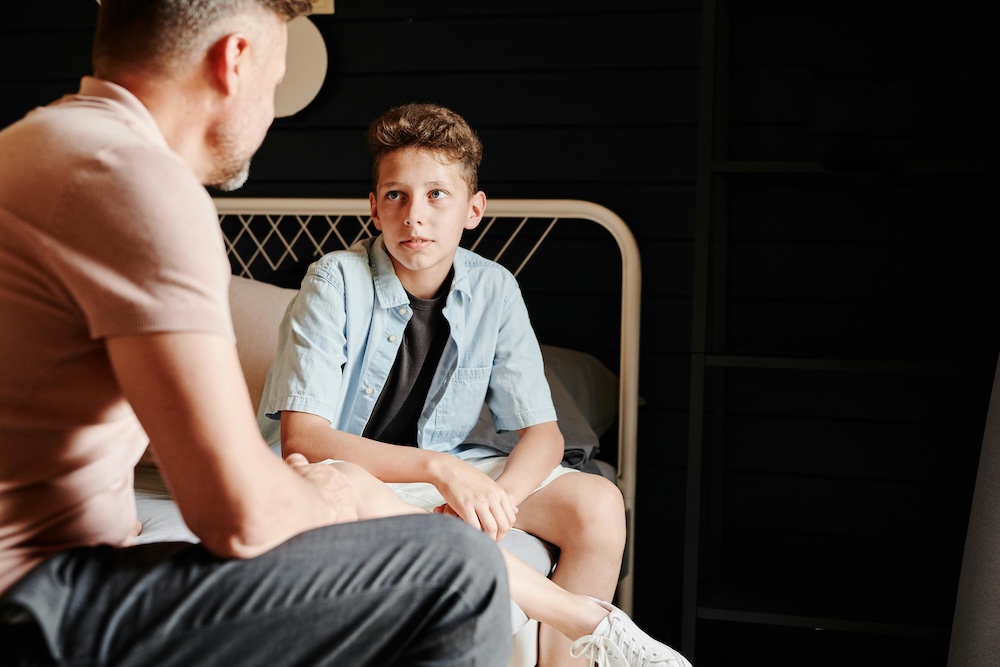The world can sometimes feel overwhelming—not just for adults, but especially for children. Whether it’s a natural disaster on the news, a loss in the family, or big changes at home, kids rely on the adults around them to help make sense of life’s hardest moments.
Talking about these experiences isn’t always easy, but when we hold space for honest, age-appropriate conversations, we give children a chance to feel heard, grounded, and supported.
At Soul Shoppe, we believe every moment is an opportunity for connection. This includes the tough ones. In this article, we’ll share gentle, SEL-informed guidance for how to talk to your child about difficult topics, from natural disasters to grief and beyond.
Why These Conversations Matter
When children face uncertainty or distress and don’t have the language or support to process it, their emotions can build up and show up in unexpected ways, like outbursts, anxiety, or withdrawal.
They may not ask directly, but they are listening. They’re watching how we react and what we say (or don’t say). By being present and honest in a developmentally appropriate way, we model emotional resilience and invite children into safe, supportive conversations.
A Gentle List of Tough Topics to Talk About
Below are some hard topics to talk about that children may experience or hear about in school, at home, or through the media.
- Natural disasters (e.g., earthquakes, wildfires, hurricanes)
- Violence in the news or community
- Death of a pet, loved one, or public figure
- Divorce or separation
- Illness or medical emergencies
- Big changes like moving or changing schools
- Environmental issues (e.g., climate change)
- Global conflict or war
Each of these can prompt big feelings, confusion, and questions, especially when they’re unexpected.
How to Talk to a Child About Difficult Topics
 Let’s walk through a few ways to open up these conversations with care and connection.
Let’s walk through a few ways to open up these conversations with care and connection.
1. Start with a Check-In
Before diving into any tough topic, create space to see how your child is already feeling. You might say:
- “Have you heard anything about what happened today?”
- “How are you feeling about everything?”
- “I noticed you’ve been quiet lately—want to talk?”
Children may not always have the words, but asking opens the door for connection.
2. Keep Language Clear, Honest, and Age-Appropriate
You don’t have to explain everything, but children do need clarity. Speak truthfully, using simple language that matches their developmental stage.
Example:
- For a natural disaster: “There was a big storm in the city next to us. People are helping to keep everyone safe.”
- For death: “That means their body stopped working, and they won’t come back. It’s okay to feel sad.”
Avoid overcomplicating or minimizing. Honesty, even in small doses, builds trust.
3. Reassure, Without Overpromising
Children want to know: Am I safe? Are the people I love safe?
- Offer comfort with facts: “We’re safe right now.”
- Remind them of the helpers: “There are so many people working to help others.”
And let them know it’s okay to have big feelings: “It’s normal to feel scared or sad about this.”
4. Let Emotions Have Space
Tears, silence, anger—these are all natural responses to stress or grief. Rather than rushing to “fix” the feeling, be a calm presence beside it.
- “It’s okay to cry. I’m here with you.”
- “You don’t have to talk right now. Just know I’m here when you’re ready.”
When navigating children and grief, know that it doesn’t follow a straight line. Some days will be heavy, others lighter. Keep the door open for ongoing conversations.
Examples of Difficult Topics in Real Life—and How to Talk Through Them
Here are a few real-world scenarios with sample language you can adapt:
A Natural Disaster on the News
“Something big happened, and lots of people are working hard to help. It might feel scary, but we’re safe here. Would you like to talk more about it or ask questions?”
When a Pet or Family Member Dies
“[Name] died, and that means we won’t see them again. It’s okay to feel sad or miss them. I miss them too. Want to remember a favorite story together?”
Divorce or Separation
“Things are changing, but what stays the same is how much we both love you. You’re not alone in this—we’ll go through it together.”
These conversations are hard, but they’re also deeply healing.
How Social Emotional Learning Supports Tough Conversations
SEL gives children the tools to name their emotions, regulate their bodies, and connect with empathy—skills that are essential during times of stress or change.
At Soul Shoppe, our social emotional learning programs, like Tools of the Heart, offer age-appropriate activities that help children build inner resilience.
Whether it’s learning to breathe through strong emotions, practicing kindness, or navigating peer conflict, SEL makes space for the kind of emotional growth that supports kids during life’s hardest moments.
Helpful Tips for Grown-Ups Navigating These Topics
Be okay with not having all the answers. Saying, “I don’t know, but we can find out together,” is powerful.
Limit overexposure to media. Curate age-appropriate news and take breaks when needed.
Use art, storytelling, or play to help kids express themselves.
Model emotional regulation. Let them see you take deep breaths, pause, or ask for help.
Check in later. Conversations around childhood stress or grief are ongoing—don’t make it a one-time event.
You Don’t Have to Do It Alone
If a child is dealing with grief, fear, or ongoing distress, it’s okay to seek support.
- Speak with school counselors
- Share grief resources for students
- Reach out to community programs and educators trained in SEL
Even small steps—like a breathing exercise or a reassuring word—can mean everything to a child.
Be the Safe Place
Learning how to talk to your child about difficult topics isn’t about having all the answers—it’s about being the steady, supportive presence children can trust.
By meeting kids with honesty, empathy, and calmness, you show them that even when the world feels big or uncertain, they are not alone.
And in that safe space, healing can begin.
You May Also Like:


